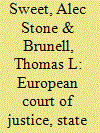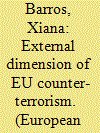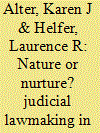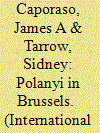|
|
|
Sort Order |
|
|
|
Items / Page
|
|
|
|
|
|
|
| Srl | Item |
| 1 |
ID:
114187


|
|
|
|
|
| Publication |
2012.
|
| Summary/Abstract |
This article analyzes the social potential of regional integration processes by using the example of European integration. Recent case law from the European Court of Justice has led some observers to argue that judicial decisions increasingly provide European politics with a "Polanyian" drive. We test this claim by distinguishing three dimensions to European economic and social integration: market-restricting integration, market-enforcing integration, and the creation of a European area of nondiscrimination. We also identify two forms of integration that have different speeds, scopes, and potentials: political integration and judicial integration. The evidence shows that the EU has come closer to Hayek's vision of "interstate federalism" than is usually warranted because market-enforcing integration and European nondiscrimination policies have asymmetrically profited from "integration through law." The opportunities for international courts to push ahead market-enforcing integration increase as the participants of regional integration processes become more diverse. In such "Hayekian" constellations, individual rights are increasingly relocated to the central level, at the cost of subordinating the decentralized capacity for solidarity and interpersonal redistribution.
|
|
|
|
|
|
|
|
|
|
|
|
|
|
|
|
| 2 |
ID:
113549


|
|
|
|
|
| Publication |
2012.
|
| Summary/Abstract |
In an article previously published by the APSR, Carrubba, Gabel, and Hankla claim that the decision making of the European Court of Justice (ECJ) has been constrained-systematically-by the threat of override on the part of member state governments, acting collectively, and by the threat of noncompliance on the part of any single state. They also purport to have found strong evidence in favor of intergovernmentalist, but not neofunctionalist, integration theory. On the basis of analysis of the same data, we demonstrate that the threat of override is not credible and that the legal system is activated, rather than paralyzed, by noncompliance. Moreover, when member state governments did move to nullify the effects of controversial ECJ rulings, they failed to constrain the court, which continued down paths cleared by the prior rulings. Finally, in a head-to-head showdown between intergovernmentalism and neofunctionalism, the latter wins in a landslide.
|
|
|
|
|
|
|
|
|
|
|
|
|
|
|
|
| 3 |
ID:
116196


|
|
|
|
|
| Publication |
2012.
|
| Summary/Abstract |
Since 11 September 2001, the European Union (EU) has significantly increased its involvement in counter-terrorism. A sizeable cluster of those new EU counter-terrorism acts were challenged in front of the European Court of Justice, and many of those acts ended being annulled by the Court. In the foreign dimension, the European Parliament challenged three counter-terrorist acts: the first Transatlantic Agreement on passenger name records, the EU technical assistance to the Philippines and the EU UN terror list. The analysis of the nature and implications of these three cases shed light on the evolving configuration of the EU foreign policy in terms of both institutional design and ideological choices.
|
|
|
|
|
|
|
|
|
|
|
|
|
|
|
|
| 4 |
ID:
023044


|
|
|
|
|
| Publication |
Nov 2002.
|
| Description |
933-964
|
|
|
|
|
|
|
|
|
|
|
|
|
|
|
|
| 5 |
ID:
062367


|
|
|
| 6 |
ID:
099871


|
|
|
|
|
| Publication |
2010.
|
| Summary/Abstract |
Are international courts power-seeking by nature, expanding the reach and scope of international rules and the courts' authority where permissive conditions allow? Or, does expansionist lawmaking require special nurturing? We investigate the relative influences of nature versus nurture by comparing expansionist lawmaking in the European Court of Justice (ECJ) and the Andean Tribunal of Justice (ATJ), the ECJ's jurisdictional cousin and the third most active international court. We argue that international judges are more likely to become expansionist lawmakers where they are supported by substate interlocutors and compliance constituencies, including government officials, advocacy networks, national judges, and administrative agencies. This comparison of two structurally identical international courts calls into question prevailing explanations of ECJ lawmaking, and it suggests that prevailing scholarship puts too much emphasis on the self-interested power-seeking of judges, the importance of institutional design features, and the preferences of governments to explain lawmaking by international courts.
|
|
|
|
|
|
|
|
|
|
|
|
|
|
|
|
| 7 |
ID:
092082


|
|
|
|
|
| Publication |
2009.
|
| Summary/Abstract |
Many have argued that the success of European integration is predicated on reinforcing market structures and some have gone further to state that the creation of a transnational market results in a decoupling of markets from their national political and social frameworks, thus threatening to unravel historical social bargains. Drawing on the work of Karl Polanyi and John Ruggie and using their insights regarding the social embedding of markets, we dissent from this view by examining how the European Court of Justice (ECJ) has handled a key sector of the emerging European market-labor mobility. We argue that rather than disembedding markets, decisions of the ECJ-just as Polanyi and Ruggie would have predicted-activate new social and political arrangements. We find evidence for the development of a new legal and political structure, largely inspired by the Court but also imbricated in European Union legislation, at the regional level.
|
|
|
|
|
|
|
|
|
|
|
|
|
|
|
|
| 8 |
ID:
113550


|
|
|
|
|
| Publication |
2012.
|
| Summary/Abstract |
In 2008 we published an article finding evidence for political constraints on European Court of Justice (ECJ) decision making. Stone Sweet and Brunell (this issue) argue that our theoretical foundations are fundamentally flawed and that our empirical evidence supports neofunctionalism over intergovernmentalism "in a landslide." We respectfully disagree with Stone Sweet and Brunell regarding both their conclusions about our theoretical arguments and what the empirical evidence demonstrates. We use this response to clarify our argument and to draw a clearer contrast between our and their perspective on the role the ECJ plays in European integration. Finally, we reevaluate their neofunctionalist hypotheses. Ultimately, we do not find support in the data for Stone Sweet and Brunell's empirical claims.
|
|
|
|
|
|
|
|
|
|
|
|
|
|
|
|
| 9 |
ID:
098470


|
|
|
|
|
| Publication |
2010.
|
| Summary/Abstract |
Non-compliance occurs in all international organizations and hampers the effectiveness of international law. Despite increasing international legalization, we know little about how international courts abolish non-compliance. Why do states sometimes abolish non-compliance before but sometimes only after judgements or even threats with penalties? This article argues, first, that there are few differences between weak and powerful states in reacting to the European Court of Justice. Second, contrary to the expectation of legalization approaches, judicial means, such as judicial discourses, cannot always facilitate compliance. Third, by contrast to the expectations of enforcement theories, powerful states do not resist judgements and sanction-threats to a greater extent than weak states. Fourth, non-country variables, such as the gravity of the infringement or the choice of judicial interpretational devices, are scope conditions for the success of judicial discourse and sanctions and are crucial in explaining how norm violations of weak and powerful states can be resolved by the international courts.
|
|
|
|
|
|
|
|
|
|
|
|
|
|
|
|
|
|
|
|
|